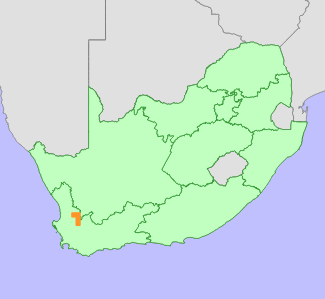|
Scientific Name | Othonna humilis Schltr. |
Higher Classification | Dicotyledons |
Family | ASTERACEAE |
National Status |
Status and Criteria | Rare |
Assessment Date | 2019/04/03 |
Assessor(s) | L. von Staden |
Justification | A rare, range-restricted species with an extent of occurrence (EOO) of 293 km². It is not threatened. It is therefore listed under the IUCN 3.1 Criteria, globally, as Least Concern but is nationally categorised as Rare. |
Distribution |
Endemism | South African endemic |
Provincial distribution | Western Cape |
Range | This species occurs in Cederberg and eastern Koue Bokkeveld. |
Habitat and Ecology |
Major system | Terrestrial |
Major habitats | Agter-Sederberg Shrubland, Cederberg Sandstone Fynbos, Swartruggens Quartzite Fynbos |
Description | Plants grow on rocky crevices and gravelly slopes, typically on shale bands. |
Threats |
| This species' habitat is protected in the Cederberg. Recent field observations in the Koue Bokkeveld noted no severe threats to the subpopulation in this area. |
Population |
This species is known from only a few, scattered records within a limited area. The population is not suspected to be declining.
|
Population trend | Stable |
Assessment History |
Taxon assessed |
Status and Criteria |
Citation/Red List version | | Othonna humilis Schltr. | Rare | Raimondo et al. (2009) | |
Bibliography |
Goldblatt, P. and Manning, J.C. 2000. Cape Plants: A conspectus of the Cape Flora of South Africa. Strelitzia 9. National Botanical Institute, Cape Town.
Manning, J.C. and Goldblatt, P. 2012. Plants of the Greater Cape Floristic Region 1: The Core Cape Flora. Strelitzia 29. South African National Biodiversity Institute, Pretoria.
Raimondo, D., von Staden, L., Foden, W., Victor, J.E., Helme, N.A., Turner, R.C., Kamundi, D.A. and Manyama, P.A. 2009. Red List of South African Plants. Strelitzia 25. South African National Biodiversity Institute, Pretoria.
|
Citation |
| von Staden, L. 2019. Othonna humilis Schltr. National Assessment: Red List of South African Plants version 2024.1. Accessed on 2025/12/02 |
 Comment on this assessment
Comment on this assessment


